Black sapote, Black persimmon
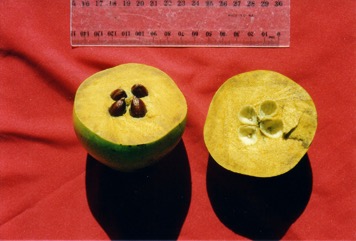
A tropical plant. It grows in lowland and mountain forests up to 1,800 m above sea level. It suits hot tropical lowland areas. In Mexico trees grow from sea level to 1800 m altitude. They will grow in most soils. Fully grown trees can tolerate 1-2°C of frost. It can grow in arid places. It suits hardiness zones 11-12.
Also known as:
Biaahui, Biaqui, Bom-rza, Bonza, Caca-poule, Chocolate pudding fruit, Cuputishim Ebano, Ebano, Guayabote, Hunchuikle, Inu, Junchuikl, Malisuuruata, Ma-ta-mui, Mueque, Munec, Muneque, Pillahui, Pohon kesemek hitam, Sapote negro, Saual, Sirunda-urata, Ta-toho, Talang-gubat, Tauch, Tauch-ya, Tauche, Tilzapot, Tilzapoti, Totocuitlzapoti, Tsupilul, Tzapultiltic, Xency, Xinde, Zapote negro, Zapote prieto
Synonyms
- The correct name is now Diospyros nigra (J. F. Gmel.) Perrier Diospyros digyna Jacq.
- Diospyros edulis Lodd. ex Sweet
- Diospyros nigra (Blanco) Blanco
- Diospyros obtusifolia Humb. & Bonpl. ex Willd.
- Diospyros obtusifolius Humb. & Bonpl.
- Diospyros pauciflora C. B.Rob. [Illegitimate]
- Diospyros revoluta Poir.
- Diospyros sapota Roxb. [Illegitimate]
- Diospyros tilzapotl Sesse & Moc.
- Sapota nigra Blanco
- Sapota nigra J. F. Gmelin
Edible Portion
- Fruit
Where does Black sapote grow?
Found in: Africa, Asia, Australia, Belize, Brazil, Caribbean, Central America, Colombia, Cook Islands, Costa Rica, Cuba, Dominican Republic, Ecuador, El Salvador, Guatemala, Haiti, Hawaii, Honduras, Indonesia, Malaysia, Mauritius, Mexico, Nicaragua, North America, Pacific, Panama, Philippines, Pohnpei, Puerto Rico, SE Asia, Singapore, South America, United States, West Indies
Notes: Plants have 3-4 x the Vitamin C of oranges. There are about 485 species of Diospyros mostly in the tropics. The correct name in now Diospyros nigra (J. F. Gmel.) Perrier - but can't rename photos!
Status: It is a commercially cultivated fruit.
Growing Black sapote, Black persimmon
Cultivation: Plants are usually grown from seed. Seed germinate 30 days after sowing. Seedlings are transplanted into pots and into the field after 1-2 years. Young healthy stems can be air-layered. Trees can be shield budded. A spacing of 6-8 m is suitable. Plants can also be grafted.
Edible Uses: The fruit are eaten fresh. They are also good for desserts. They are used in pies, preserves, ice cream and cakes and other desserts. They are used for jam. They are also fermented into a brandy like drink.
Production: It is slow growing. Fruit are produced 5 year after planting. The fruit are ripe when the calyxes around the stem start to lift. Fruit mature in 200-300 days.
Nutrition Info
per 100g edible portion| Edible Part | Energy (kcal) | Protein (g) | Iron (mg) | Vitamin A (ug) | Vitamin c (mg) | Zinc (mg) | % Water |
|---|---|---|---|---|---|---|---|
| - | - | - | - | - | - |
Black sapote, Black persimmon Photos

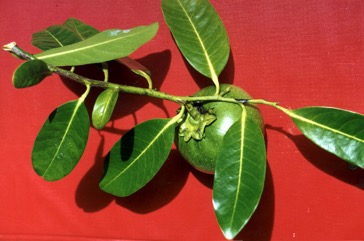
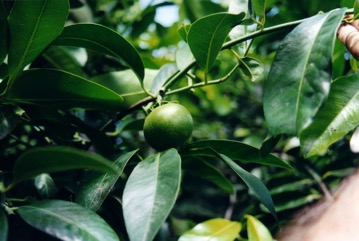
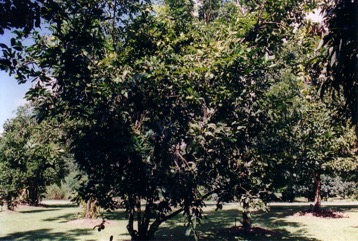
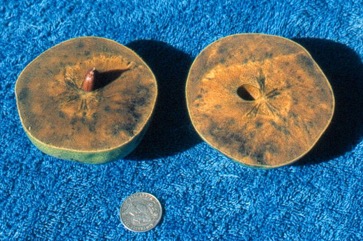
References
Black sapote references Diospyros nigra
Burkill, I.H., 1966, A Dictionary of the Economic Products of the Malay Peninsula. Ministry of Agriculture and Cooperatives, Kuala Lumpur, Malaysia. Vol 1 (A-H) p 842 (As Diospyros ebenaster)
Cheifetz, A., (ed), 1999, 500 popular vegetables, herbs, fruits and nuts for Australian Gardeners. Random House p 188 (As Diospyros digyna)
Coronel, R.E., 1982, Fruit Collections in the Philippines. IBPGR Newsletter p 6 (As Diospyros ebenaster)
Cruz, I. M., et al, 2015, Edible fruits and seeds in the State of Mexico. Revista Mexicana de Ciencias Agricolas. Vol. 6. Num. 2 pp 331-346
Darley, J.J., 1993, Know and Enjoy Tropical Fruit. P & S Publishers. p 26 (As Diospyros digyna)
Facciola, S., 1998, Cornucopia 2: a Source Book of Edible Plants. Kampong Publications, p 92 (As Diospyros digyna)
Food Composition Tables for use in East Asia FAO http://www.fao.org/infoods/directory No. 968 (As Diospyros ebenaster)
Gomez Pompa & Sosa, eds. 1978-. Flora de Veracruz (As Diospyros digyna)
Gonzalez-Espinosa, M. et al, 2011, The Red List of Mexican Cloud Forest Trees. Flora and Fauna International, Cambridge. p 27
Gouldstone, S., 1983, Growing your own Food-bearing Plants in Australia. Macmillan p 127 (As Diospyros ebenaster), p 122 (As Diospyros obtusifolia)
Grandtner, M. M., 2008, World Dictionary of Trees. Wood and Forest Science Department. Laval University, Quebec, Qc Canada. (Internet database http://www.WDT.QC.ca) (Also as Diospyros ebenaster)
Grandtner, M. M. & Chevrette, J., 2013, Dictionary of Trees, Volume 2: South America: Nomenclature, Taxonomy and Ecology. Academic Press p 202 (As Diospyros digyna)
Hedrick, U.P., 1919, (Ed.), Sturtevant's edible plants of the world. p 278 (As Diospyros obtusifolia)
Hermandez Bermejo, J.E., and Leon, J. (Eds.), 1994, Neglected Crops. 1492 from a different perspective. FAO Plant Production and Protection Series No 26. FAO, Rome. p 15 (As Diospyros digyna)
Hibbert, M., 2002, The Aussie Plant Finder 2002, Florilegium. p 87 (As Diospyros digyna)
Ibarra-Manriquez, G., et al, 1997, Useful Plants of the Los Tuxtlas Rain Forest (Veracruz, Mexico): Considerations of their Market Potential. Economic Botany, Vol. 51, No. 4, pp. 362-376 (As Diospyros digyna)
John, L., & Stevenson, V., 1979, The Complete Book of Fruit. Angus & Robertson p 284 (As Diospyros digyna)
Kermath, B. M., et al, 2014, Food Plants in the Americas: A survey of the domesticated, cultivated and wild plants used for Human food in North, Central and South America and the Caribbean. On line draft. p 313 (As Diospyros revoluta)
Kiple, K.F. & Ornelas, K.C., (eds), 2000, The Cambridge World History of Food. CUP p 1734 (As Diospyros digyna)
Llamas, K.A., 2003, Tropical Flowering Plants. Timber Press. p 186 (As Diospyros digyna)
Lorenzi, H., Bacher, L., Lacerda, M. & Sartori, S., 2006, Brazilian Fruits & Cultivated Exotics. Sao Paulo, Instituto Plantarum de Estuados da Flora Ltda. p 400 (As Diospyros digyna)
Lyle, S., 2006, Discovering fruit and nuts. Land Links. p 181 (As Diospyros digyna)
Martin, F. W., et al, 1987, Perennial Edible Fruits of the Tropics. USDA Handbook 642 p 25 (As Diospyros ebenaster)
Miguel, E., et al, 1989, A checklist of the cultivated plants of Cuba. Kulturpflanze 37. 1989, 211-357 (As Diospyros digyna)
Milow, P., et al, 2013, Malaysian species of plants with edible fruits or seeds and their evaluation. International Journal of Fruit Science. 14:1, 1-27 (As Diospyros digyna)
Morton, Julia F., 1987, Fruits of Warm Climates. Creative Resources Systems, Inc. . p. 416 (As Diospyros digyna)
Norrington, L., & Campbell, C., 2001, Tropical Food Gardens. Bloomings Books. p 95 (As Diospyros digyna)
Pl. hort. schoenbr. 3:35, t. 313. 1803 (As Diospyros digyna)
Purseglove, J.W., 1968, Tropical Crops Dicotyledons, Longmans. p 646 (As Diospyros digyna)
Recher, P, 2001, Fruit Spirit Botanical Gardens Plant Index. www.nrg.com.au/~recher/ seedlist.html p 2 (As Diospyros digyna)
Royal Botanic Gardens, Kew (1999). Survey of Economic Plants for Arid and Semi-Arid Lands (SEPASAL) database. Published on the Internet; http://www.rbgkew.org.uk/ceb/sepasal/internet [Accessed 16th April 2011] (As Diospyros digyna)
Segura, S., et al, 2018, The edible fruit species in Mexico. Genet Resour Crop Evol (2018) 65:1767–1793 (Also as Diospyros revoluta)
Smith, N., Mori, S.A., et al, 2004, Flowering Plants of the Neotropics. Princeton. p 136 (As Diospyros digyna)
Solomon, C., 2001, Encyclopedia of Asian Food. New Holland. p 329 (As Diospyros digyna)
Standley & Steyerm. 1946-1976. Flora of Guatemala. (As Diospyros digyna)
Staples, G.W. and Herbst, D.R., 2005, A tropical Garden Flora. Bishop Museum Press, Honolulu, Hawaii. p 272 (As Diospyros digyna)
Sukarya, D. G., (Ed.) 2013, 3,500 Plant Species of the Botanic Gardens of Indonesia. LIPI p 240
Tankard, G., 1990, Tropical fruit. An Australian Guide to Growing and using exotic fruit. Viking p 26 (As Diospyros digyna)
Terrell et al. 1986. Agric. Handb. no. 505. (AH 505) (As Diospyros digyna)
USDA, ARS, National Genetic Resources Program. Germplasm Resources Information Network - (GRIN). [Online Database] National Germplasm Resources Laboratory, Beltsville, Maryland. Available: www.ars-grin.gov/cgi-bin/npgs/html/econ.pl (10 April 2000) (As Diospyros digyna)
van Wyk, B., 2005, Food Plants of the World. An illustrated guide. Timber press. p 179 (As Diospyros digyna)
Verheij, E. W. M., and R. E. Coronel, eds. 1991. Edible fruits and nuts. In: E. W. M. Verheij & R. E. Coronel (eds.), Plant Resources of South-East Asia (PROSEA). 2:152 (As Diospyros digyna)
Woodson & Schery, eds. 1943-1980. Flora of Panama (As Diospyros digyna)
World Checklist of Useful Plant Species 2020. Royal Botanic Gardens, Kew
www.worldagroforestrycentre.org/sea/products/afdbases/af/asp/SpeciesInfo.asp?SpID=18080 (As Diospyros digyna)